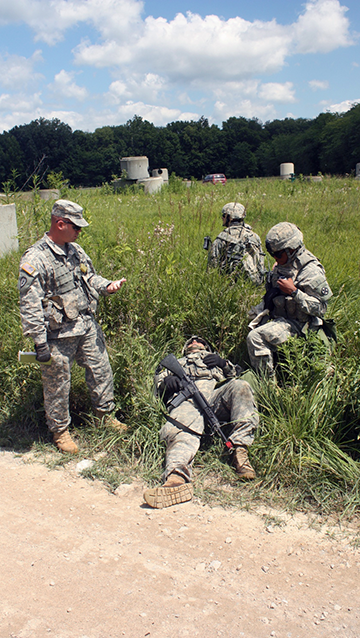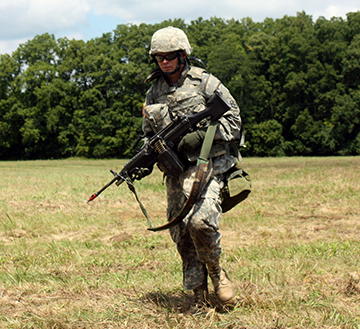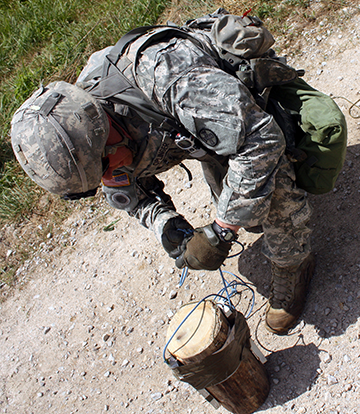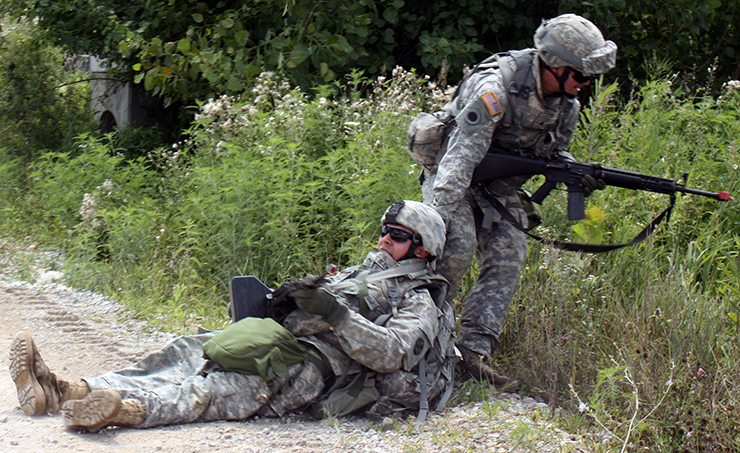Ohio National Guard News
Evaluation tests Sappers' 'METL'Army National Guard unit gets readiness assessment by First ArmyStory and photos by Sgt. Brian Johnson, 196th Mobile Public Affairs Detachment |
|
A Soldier with the Ohio Army National Guard’s 811th Engineer Company (Sapper) works to move one of his comrades with a simulated injury to safety, July 24, 2014, at Camp Atterbury, Ind. As part of their two-week annual training, the Soldiers of the 811th were evaluated on tasks comprising their METL (Mission Essential Task List), an assessment that helps determine the unit’s readiness and availability for any missions that the Army may call upon them for in the future. READ STORY |
|

ABOVE: A Soldier gets guidance from a First Army evaluator about what simulated injuries his fellow Soldier has and how to treat them. TOP RIGHT: A Soldier moves to his next mission objective. RIGHT: A Soldier works to prepare a simulated shape charge |
 |
 |
|
The results of that evaluation are what tell the Army if a unit is ready for combat operations, or if additional training may be needed to make the unit ready to meet the needs of the Army. During their two-week annual training period this summer, more than 80 members of the Ohio Army National Guard's Amanda, Ohio-based 811th Engineer Company (Sapper) were evaluated on their unit readiness by First Army. A Sapper is the name for the Army combat engineers who conduct mobility and counter-mobility operations on the battlefield, including bridge-building, laying or clearing minefields and demolitions. Capt. Thomas Race, commander of the 811th, explained that the unit has to show proficiency in their Mission Essential Task List (METL), tasks. “We are currently running operations to show mobility, counter-mobility, engineer combat operations and command and control.” Race said. Staff Sgt. Joshua Bruce, a construction operations sergeant from Lancaster, Ohio, explained how the training works. “To get Soldiers to adapt to the training environment, we have them go through multiple, different lanes,” Bruce said. “Each time we have made the mission a little bit harder. Each day we have progressively added more obstacles into it.” |
Bruce said that there are three platoons in the 811th that are all set up identically. “They (the platoons) all go through the same lanes,” Bruce said. “We change them every day so that when the young Soldiers talk to each other, they can't give real clues and tips to what is happening.” At this point in their training, Race said the unit had been running an eight-phase operation almost nonstop for nearly 72 hours. “Last night we did a night recon of a bridge,” Race said. “Today we set up a traffic control point while another platoon blew up a bridge.” The next mission involved disrupting a potential helicopter landing zone. With so many various, detailed scenarios, Race said that the planning that went into this annual training took most of the past year. Bruce said that the feedback about the training earlier this year has been nothing but positive. “The E-5s and below love this. A lot of them have been saying for the last four or five years that we never do this awesome (kind) of training,” Bruce said. “The esprit-de-corps is through the roof.” When the unit's two-week annual training period and evaluation were completed, they returned home to stand at the ready in case the Army needs a Sapper unit like the 811th. If it does, the 811th could potentially meet that need and be ready to go. |

